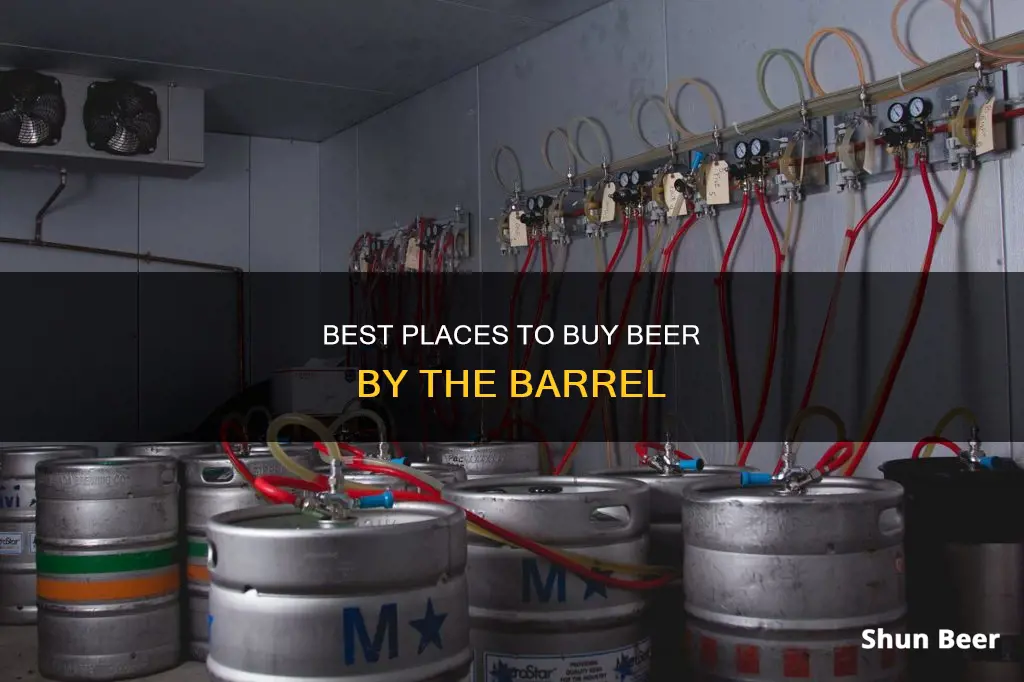
If you're looking to buy a barrel of beer, there are a few things to consider. Firstly, you'll need to decide on the size of the barrel you require – options include mini, Cornelius, log (sixth barrel), pony (quarter barrel), and full (half barrel) kegs. The number of servings you'll get from each varies, from 14 to 165 12-ounce beers. It's also worth noting that some states have restrictions on keg size and type, so be sure to check the laws where you live.
Once you know what size you need, you can start looking for a place to buy from. Liquor stores, breweries, wineries, and even some restaurants sell kegs. It's a good idea to choose a vendor that's located near your party or event and stocks the type of beer you want. Most places will require you to order your keg in advance, and you'll need to provide ID when you pick it up – in the US, you must be at least 21 years old to buy alcohol.
Kegs can be pretty heavy, so you might also want to rent some additional equipment, like a tap, a bucket for chilling the beer, or even a kegerator – a refrigerator designed specifically for kegs. These items usually come with a refundable deposit, and you'll also need to pay for the beer itself. When you're done, remember to return the keg and any rented accessories by the specified deadline to get your deposit back.
| Characteristics | Values |
|---|---|
| Keg sizes | Half barrel, quarter barrel, sixth barrel, Cornelius keg, mini-keg |
| Number of beers in a keg | 14 to 165 12-ounce beers |
| Keg couplers | A, D, G, M, S, and U |
| Keg cost | Varies depending on the size and brand of beer |
| Keg weight | A full keg weighs roughly 162 pounds |
What You'll Learn

Keg sizes and how many beers they hold
There are several different sizes of kegs, which hold varying amounts of beer. Here is a list of the most common keg sizes and how many beers they hold:
Mini Keg
A mini keg is perfect for a small gathering. It usually holds around 5 litres of beer, which is approximately 14 12-ounce pours or 10 16-ounce pints.
Cornelius Keg
The Cornelius keg, also known as the Corny Keg, was originally designed for storing and distributing soda. It has a capacity of 5 gallons or 18 litres and can hold about 53 12-ounce cans or bottles of beer, or 40 16-ounce pints.
Sixth Barrel Keg
The sixth barrel keg, also known as a Sixtel or Log, is slightly bigger than the Cornelius keg, with a capacity of 5.16 gallons or 20 litres. It can hold up to 55 12-ounce bottles or cans, or 41 16-ounce pints.
Quarter Barrel Keg
The quarter barrel keg, also called a Pony Keg or Stubby Quarter, is often seen at keg parties. Despite its short and stubby appearance, it holds more beer than the Cornelius or Sixth Barrel keg—about 7.75 gallons or 30 litres. It can hold 82 12-ounce bottles or cans, or 62 16-ounce pints, making it perfect for small to medium-sized parties.
Slim Quarter Keg
The Slim Quarter Keg is a taller and slimmer version of the Quarter Barrel Keg, holding the exact same amount of beer.
Half Barrel Keg
The Half Barrel Keg, also known as the Full Size Keg or Full Keg, is the most common and widely distributed type of keg. It has a capacity of 15.5 gallons and can hold approximately 165 12-ounce cans or bottles, or 124 16-ounce pints.
50 Litre Keg
The 50 Litre Keg is commonly used in Europe and the UK. It holds 50 litres or 13.2 gallons of beer, which is approximately 140 12-ounce cans or bottles, or 105 16-ounce pints.
Tilray's Beer Brands: Crafting a New Buzz
You may want to see also

Where to buy a barrel of beer
There are many places to buy a barrel of beer, both online and in-store. If you're looking to buy a barrel of beer in-store, you can try liquor stores, breweries, wineries, or even some restaurants. If you're looking to buy a barrel of beer online, you can try websites such as Total Wine & More, The Liquor Book, Discount Liquor, or Craftshack.
When buying a barrel of beer, there are a few things to keep in mind. First, you need to figure out how much beer you need. There are several different sizes of kegs available, including mini kegs, Cornelius kegs, log kegs (sixth barrel), pony kegs (quarter barrel), and full kegs (half barrel). The number of beers in a keg can range from 14 to 165 12-ounce beers, so choose the size that best suits your needs.
Another thing to consider is the type of beer you want. Different types of beer will have different prices, so be sure to check with the store or website to see what options are available. Additionally, some places may require you to place your order in advance, especially if you're looking for a specific type of beer.
When picking up your barrel of beer, don't forget to bring government-issued ID to prove that you're of legal drinking age. You may also need to provide the address where the keg is going, the approximate date and time of consumption, and your vehicle's license plate. You will also need to sign paperwork accepting responsibility for the keg and pay any deposits and fees.
Finally, keep in mind that kegs can be heavy, so you may need a dolly or a friend to help you lift it. By following these tips, you should be able to buy a barrel of beer with ease!
Missouri's Early Beer Purchase: What's the Earliest Legal Time?
You may want to see also

How to transport a beer barrel
Transporting a beer barrel requires careful planning and the right equipment. Here are some detailed instructions to help you safely transport a beer barrel:
Plan Ahead:
Before you transport a beer barrel, it is important to plan ahead. Estimate the amount of beer you will need and choose the appropriate barrel size. Standard barrel sizes include mini kegs, Cornelius kegs, log kegs, pony kegs, and full kegs.
Choose a Pickup Location:
Select a store that sells beer barrels and is conveniently located near your party or event. Liquor stores, breweries, and even some restaurants offer beer barrels for sale.
Place Your Order in Advance:
It is recommended to place your order for the beer barrel at least 10 days in advance to ensure that your specific requirements are met. While some places may accommodate last-minute orders, the selection and size options may be limited.
Secure Necessary Permits:
If you plan to serve beer at a special event like a wedding or fundraiser, don't forget to obtain the necessary permits from your state's liquor control board. For private parties, apply for a banquet permit, while nonprofit organizations will need a special occasion permit.
Prepare for Pickup:
On the day of pickup, ensure you have a valid government-issued ID to prove your age (21 or older in the US). Bringing a credit card is also advisable, as you will need it for the deposit, even if you pay in cash. Keep in mind that keg deposits can be quite costly, ranging from $30 to $75 or more.
Transporting the Barrel:
When transporting the beer barrel, use a dolly or cart to move it, especially if it is full. A filled barrel can weigh around 162 pounds, so having a helper and a dolly will make the task much easier. If possible, transport the barrel in a vehicle that can accommodate its size and weight, ensuring it is secured safely to avoid damage during transit.
Rent Accessories:
Don't forget to rent or purchase additional accessories like a tap, chilling bucket, kegerator, or jockey box to dispense and store the beer. These items can usually be rented from the same place you bought the beer barrel.
Store and Serve the Beer:
Keep the beer barrel cold by using a chilling bucket filled with ice or a kegerator, which is a specialised refrigerator for kegs. The ideal serving temperature for beer is around 38 °F (3 °C). Allow the barrel to settle for at least an hour before tapping to ensure optimal beer quality.
Returning the Keg:
Remember to empty the keg before returning it and remove the tap to avoid any issues with open containers during transport. Return the keg and all rented accessories by the specified deadline to receive your deposit refund. Ensure that the identifying sticker or mark on the keg is still intact, as this will be checked upon return.
The Ultimate Guide to Buying Australian Beer
You may want to see also

How to store a beer barrel
Storing a beer barrel requires a bit of preparation and care. Here are some detailed instructions on how to store a beer barrel properly:
Location
Choose a storage location that is cool, dry, and dark. Avoid exposing the barrel to direct sunlight or sources of heat. The ideal temperature for storing beer is between 50-55°F (10-12.8°C). Keep the barrel away from environmental changes and fluctuations in temperature.
Position
Keep the barrel in an upright position. Storing beer upright helps to compact yeast at the bottom of the barrel and slows oxidation. It also prevents the formation of a yeast ring inside the barrel and reduces the beer's exposure to the cork, which can impart unwanted flavours.
Airflow
Ensure there is adequate airflow around the barrel. Avoid enclosing it in a space without ventilation, as this can affect the maturation process and cause stagnation. Allow for ample airflow to prevent the beer from becoming stagnant or developing mould.
Settling
Once you've placed the barrel in the desired location, let it settle for at least an hour before tapping it. This will ensure the beer is of optimal quality.
Chilling
Maintain the beer at a cool temperature of around 38°F (3°C). Use a chilling bucket filled with ice, a kegerator (a refrigerator designed for kegs), or place the barrel in a large garbage bag filled with ice to keep it chilled. Avoid letting the beer exceed 55°F (12.8°C) or drop below 28°F (-2.2°C) to prevent bacterial growth and maintain flavour and aroma.
Consume Within a Suitable Timeframe
The type of tap you use will affect how long the beer stays fresh. A manual pump will reduce the beer's quality rather quickly, so it's best to consume the beer within 8 hours to a day. Using a kegerator and CO2 can prolong freshness, and pasteurized beer can last up to 3 months, while unpasteurized beer can last about 2 months.
Non-Alcoholic Beer: Canada's Under-18 Drinking Alternative
You may want to see also

How to tap a beer barrel
Tapping a beer barrel is a simple process that won't take more than a couple of minutes. Here is a step-by-step guide on how to tap a beer barrel:
Step 1: Identify the Coupler System
Before you tap the keg, identify the type of coupler system of your keg and acquire the correct tap/coupler/pump type. Most beer kegs sold in the US use the American 'D' system, while imports will use the European 'S' system or other less common systems. Your keg distributor should be able to point you in the right direction and may even supply the correct parts.
Step 2: Chill the Keg
Use an ice bucket or a large garbage bag to keep the entire keg cold. This will help you later with pouring a perfect head and not a cup of foam. Leave the keg to chill for several hours. Don't forget to also ice your tap and beer line for about an hour before you pour.
Step 3: Remove Plastic or Cardboard from the Tap Fixture
Remove any plastic or cardboard covering from the tap fixture at the top of the keg.
Step 4: Line Up the Coupler Lugs with the Openings on the Keg Valve
With the pump handle up (this is the off position), line up the coupler lugs with the corresponding openings on the keg valve.
Step 5: Turn the Tap System Clockwise
While applying downward pressure, turn the tap system clockwise as far as it will go (about 90 degrees).
Step 6: Push the Pump Handle Down
Push the pump handle down (this is the on position). This allows gas to enter the keg and the beer to flow out. Check the seating, and if you see bubbles around the connection, it is not seated correctly. In this case, turn the pump handle back off, disconnect the pump, and try again.
Step 7: Pour Your First Beer
With a full, new keg, you will not need to pump for the first few pints as there is already enough pressure within the keg to get the beer flowing. Simply push down on the valve at the end of the beer line and pour into your drinking vessel. Your first pint will likely be all foam, which you can set aside or discard.
Step 8: Pump the Tap When the Flow Slows Down
After pouring several pints, you may wish to use the pump to build up the pressure in the keg again. Remember to only pump with the pouring valve open.
Step 9: Untap the Keg When Finished
When the keg is empty, untap it by pulling the handle upwards on the tap to the "off" position, then twist the tap counterclockwise to unscrew it.
Polk County Beer Buying Hours Explained
You may want to see also







